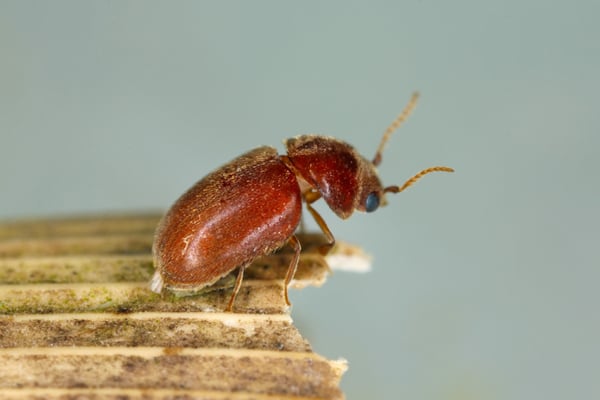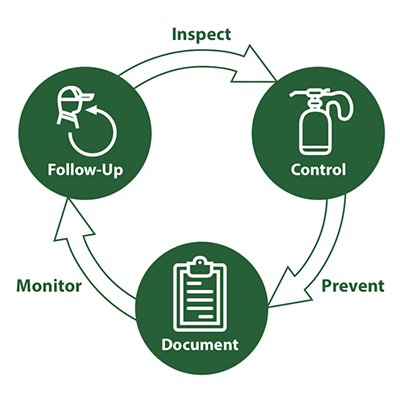Cigarette Beetle
Appearance And Behavior
The cigarette beetle (Lasioderma serricorne) is a common stored product pest found all over the world. Its common name references the fact that the beetle frequently attacks and feeds on tobacco.
Adult cigarette beetles are about 1/16 to 1/8" long, oval-shaped, and light brown. Their antennae are distinctively serrated or saw-like. The pits on cigarette beetle’s elytra (wing covers) are scattered in distribution, not arranged in rows. Their thorax and elytra are covered with fine, pale-yellow hairs called setae. The beetle’s prothoraxes bend downward, concealing the their heads from above and giving them a humped appearance.
Cigarette beetle larva is about 1/16 to 1/8" long when fully-grown. They’re white, plump, C-shaped, covered with long hairs, and have 3 pairs of tiny legs. Larvae grow continuously while developing toward adulthood, so they may be smaller when you encounter them.
The cigarette beetles’ entire life cycle usually only takes 45 to 50 days. Within this time period, cigarette beetles undergo complete metamorphosis, passing through egg, larval, pupal, and adult stages.
Female cigarette beetles lay between 30 to 100 single, white eggs in and around food materials. These eggs hatch within 6 to 10 days. Immediately upon hatching, larvae burrow into nearby food material and begin to feed continuously. Larvae continue feeding for around 30 days and then enter the dormant pupal stage to complete their development. When pupation completes, adult beetles leave their food source to seek mates and lay eggs.

Cigarette beetles attack a wide variety of dried food items. They’re common in paprika, dry dog food, beans, biscuits, chickpeas, cigars and cigarettes (naturally), cocoa beans, and coffee beans. They’ll also infest cottonseed, dates, dried fruits and vegetables, drugs, flour, dried flowers, ginger, grains, herbs, peanuts, and pepper. In a pinch, they may also attack animal material such as dried fish, meat, leather, silk, and dried insects.
Cigarette beetles most frequently infest dry dog food and paprika in people’s homes. Adult beetles fly during the late afternoon, especially on cool, cloudy days. The flying beetles are naturally attracted to light. Cigarette beetles may swarm while mating and congregate on plants in large numbers.
Cigarette Beetle Prevention

First, you should locate and remove or protect cigarette beetle’s main food sources. Keep dried food and spice in airtight, hard plastic containers whenever you’re not using them. You should also attempt to cut off the beetles from their breeding sites.
Cigarette beetles lay eggs in and around dry food sources in dark places. Make sure they can’t access your pantry, basement, or garage. Do your best to keep crumbs from accumulating and clean dining and eating areas regularly. If you find beetles or larvae, remove them using a vacuum cleaner fitted with a hose attachment.
Cigarette Beetle Control Process
A Plunkett’s pest management professional starts our treatment by locating and cleaning out cigarette beetle breeding sites. We’ll also help you figure out how to prevent beetles from accessing these sites again.
We may also apply residual insecticide dust treatments in cracks, crevices, or structural voids when appropriate. These treatments will help keep beetles from re-entering your home after we leave. In some cases, we’ll also use insecticide aerosol formulations to stop beetles from breeding in your home.
If you think you have a cigarette beetle infestation, don’t hesitate to give Plunkett’s Pest Control a call ASAP. We’ll wipe out your current infestation and make sure the beetles can’t come back.

Cigarette Beetle Control With Plunkett's
At Plunkett’s, our goal is to help you quickly, conveniently, and in the most cost-effective way. We make every effort to be with you asap, usually within a day or two.
Learn More
There are a good number of stored product pests that are particularly likely to make pests of themselves around your home. Some of the most common examples of stored product pests Plunkett’s encounters frequently include:






